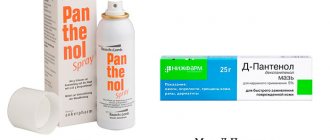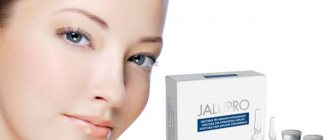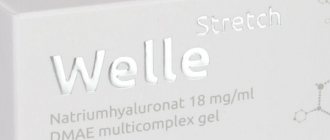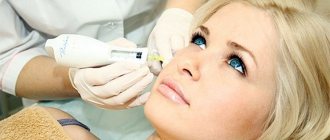Content:
Modern aesthetic cosmetology offers a huge selection of effective skin rejuvenation procedures. One of them is carboxytherapy. The method helps fight age-related changes, increases skin elasticity, eliminates wrinkles and pigmentation, and fights acne.
Carboxytherapy is an innovative method of epidermal rejuvenation based on the properties of carbon dioxide.
Carbon dioxide has antioxidant, antiseptic and restorative properties. That is why it has been used in medicine for more than 50 years. But in aesthetic medicine, the technique using carbon dioxide began to be used not so long ago.
New rejuvenation technique may have the opposite effect
Carboxytherapy is a relatively new cosmetic procedure that its proponents claim can rejuvenate the face. The method involves injecting carbon dioxide into the area around the eyes. But many question its effectiveness.
Carbon dioxide produced in the process of life is excreted from the body constantly while the blood circulates throughout the body. However, the excessive amount of gas causes the blood vessels to dilate, allowing them to transport more blood. Due to its increased influx, skin color is restored, and damaged or tone-deprived areas are regenerated faster and literally look younger.
The recovery time after this procedure is much shorter when compared with other popular rejuvenation techniques. But the results remain controversial. While some beauty industry experts place a big bet on the procedure and claim that it is almost more effective than Botox, others are not so sure of the effectiveness of this method.
In fact, there is no scientific evidence showing the effectiveness of carboxytherapy. The method does not in any way affect the causes of dark circles under the eyes, which are mainly not related to blood supply. Circles appear when the skin under the eyes thins and becomes a little translucent. As a result, small vessels and internal tissues appear through thin skin.
Only a few studies have been conducted to measure the effectiveness of carboxytherapy, but they have not supported the theory that this procedure can have a rejuvenating effect on tissue.
But more than that, ironically, the swelling that occurs after injections can aggravate another problem, for which millions of people around the world turn to cosmetologists and surgeons in search of relief. These are wrinkles around the eyes. The fact is that after therapy, the vessels dilate and the skin stretches a little, but when the injected carbon is removed, the tissues shrink again, and they do not always manage to take their previous shape. Therefore, wrinkles may become even more noticeable some time after carboxytherapy.
No matter how many new methods the beauty industry workers invent, trying to give their clients the desired youth and freshness, we should not forget that the main guarantee of beauty is health. Ochkov.Net recommends choosing only proven procedures and contacting qualified specialists.
How does carboxytherapy work?
The main reason for the aging of the epidermis is an insufficient amount of oxygen in the tissues. The effectiveness of carboxytherapy may seem questionable, because carbon dioxide causes an even greater lack of oxygen. However, CO2 saturates the skin much more effectively than oxygen. The epidermis reacts to exposure to carbon dioxide as if it were stress, and in response increases blood circulation and stimulates the active production of collagen, which is the main building material for cells.
Carboxytherapy helps fight various cosmetic imperfections, namely: - Improves blood circulation. — Restores the protective properties of the skin. - Eliminates inflammation. — Improves the overall condition of the skin. - Fights age-related changes. - Increases elasticity. — Eliminates pigmentation. - Fights acne.
The effect of hypoxia on the skin
The main consumers of oxygen are the brain, kidneys, and liver. Of course, they are primarily supplied with blood and oxygen.
When there is a lack of oxygen, the skin is the last to receive it.
- Cell division slows down and physiological renewal in the epidermis and dermis is disrupted, which provokes deterioration of color (asphyxtic skin), loss of skin turgor, and impaired melanogenesis.
- Chronic hypoxia or the entry of oxygen into the skin from air contaminated with various pollutants activates the production of free radicals that trigger an inflammatory cascade, disruption of angiogenesis, skin microflora, and accelerated aging.
- Lack of oxygen in the skin affects the activity of various biochemical processes, weakening the barrier and thermoregulatory functions of the skin, leading to dysregulation of the immune response and premature aging.
- Cell division slows down and physiological renewal in the epidermis and dermis is disrupted; complete oxidation of organic substances does not occur and, when accumulated, they cause intoxication.
- Keratinocytes produce insufficient amounts of ceramides, structural proteins (involucrin, loricrin, filaggrin), pro-inflammatory mediators (chemokines, cytokines), leading to dry skin, disruption of its barrier properties, negatively affecting its relief and color.
- In the dermis, when cells are starved of oxygen, aggregates of collagen and elastin fibers accumulate, the structure of the matrix changes, leading to a decrease in the elasticity and turgor of the skin, and the appearance of wrinkles.
Pros and cons of non-invasive carboxytherapy
Thanks to non-injection carboxytherapy, the high-quality effect of skin rejuvenation without injections can be felt instantly, painlessly and safely. The non-invasive technique preserves the integrity of the dermis and is more comfortable.
Unlike injections, after the non-invasive carboxytherapy procedure, no recovery period is required, which allows you to immediately return to your normal lifestyle.
The procedure helps improve the overall condition of the skin and also corrects minor aesthetic imperfections. However, with pronounced age-related changes, non-invasive carboxytherapy is not effective enough as an independent method of rejuvenation. For significant changes and more lasting results, an integrated approach in combination with peeling and hardware procedures will be required.
Advantages of non-injection carboxytherapy
— Pronounced results without compromising the integrity of the skin after the first procedure. — Side effects and complications are excluded. — Suitable for any skin type. - Has no age restrictions. — There are no seasonal restrictions required for the procedure. - Completely safe and painless. - No recovery period required. — Affordable price
Disadvantages of carboxytherapy without injections
— The procedure cannot eliminate pronounced age-related changes. — To obtain a pronounced result, an integrated approach in combination with other cosmetological techniques is recommended. — To obtain a lasting result, you must undergo a course of procedures. — Non-invasive carboxytherapy is not recommended for home use without prior training in the technique.
Carboxytherapy: mechanism of action
The modern method of non-invasive carboxytherapy is designed to activate the process of intracellular respiration, restore interstitial metabolism and activate the vital functions of skin cells. Essentially, this is a method of oxygenating the skin, which is based on the deep transdermal injection of molecular carbon dioxide. The release of carbon dioxide occurs directly on the surface of the skin as a result of a chemical reaction that occurs when a gel based on sodium bicarbonate is combined with an activator mask containing citric acid. A gradient of carbon dioxide concentration arises from the stratum corneum to the dermis and hypodermis. As a result of passive diffusion, CO2 combines with oxyhemoglobin and the release of oxygen is activated.
In addition, carbon dioxide, when dissolved, shifts the pH value to the acidic side. This phenomenon (the effect of pH on the affinity of hemoglobin for oxygen) is known as the Bohr effect. Carbon dioxide is a powerful vasodilator (dilates blood vessels) and reduces increased capillary tone, thereby enhancing tissue microcirculation and skin metabolism. In response to exposure to CO2 in the skin, the intensity of blood flow, cell proliferation, and the course of immune and inflammatory reactions change. The moisture-holding capacity of the skin increases and the level of hydration increases.
Non-invasive carboxytherapy CO2 CARBOXY PRO (Dermatime, Spain) is a unique two-step therapeutic system that triggers the physiological dermal process of gas exchange, promoting the removal of toxins and accelerating self-healing at the cellular level.
How is the non-invasive carboxytherapy procedure performed?
After cleansing, the cosmetologist treats the skin with lotion and performs enzyme peeling. Then apply an activator gel and a saturated mask for 20 - 25 minutes. The drug is applied with a special device, due to which the active elements penetrate into the deep layers of the epidermis. Thanks to carbon dioxide, blood vessels expand more intensively, saturating the skin with oxygen and essential elements.
Next, the cosmetologist removes the mask and applies SPF cream. The entire procedure of non-injection carboxytherapy takes about half an hour.
After a course of non-invasive carboxytherapy, the skin will become more sensitive, so you should avoid direct sunlight and be sure to apply sunscreen after the procedure.
Non-invasive carboxytherapy can be used as a single procedure to improve the overall condition of the skin, but to obtain lasting results, of course, it is better to complete the full course. In this case, non-injection carboxytherapy will improve blood circulation, reduce congestion, restore the protective properties of the skin and saturate it with oxygen.
For minor problems with the skin, for its general improvement, cosmetologists recommend taking a course of non-injection carboxytherapy once a year, and if more intensive intervention is necessary, the course should be repeated twice a year.
Course duration
Carboxytherapy for the face is a technique that involves a course of procedures. The number of sessions is calculated individually, this is influenced by several factors:
- patient's age;
- selected method of gas injection;
- skin condition;
- the nature of the defects that need to be eliminated.
With the injection method of introducing carbon dioxide, the result can be observed after 3-4 procedures. To combat the signs of aging, 5-6 invasions will be required with an interval of 2-3 days.
With the non-injection carboxytherapy technique, a course of 10-15 procedures will be required to solve cosmetic problems, restore tone and visible rejuvenation. Masks with active ingredients can be performed at intervals of 1-2 days.
Cost of carboxytherapy in Krasnodar
In Krasnodar, you can undergo an effective, painless and safe procedure of non-invasive carboxytherapy in our clinic. Experienced cosmetologists, modern equipment, high-quality certified materials guarantee excellent results. The cost of a course of non-injection carboxytherapy in our clinic is one of the most affordable in Krasnodar.
You can find out more about the carboxytherapy procedure by scheduling a consultation with our cosmetologists or dermatologists in any way convenient for you: by phone or using the feedback form.
THE MAIN THING IS TO DECIDE
Until the age of 40, I never resorted to salon procedures; I always took care of my face and body on my own.
Salons with their machines and needles evoked only mistrust and fear. However, I turned forty and I decided that it was time, I needed to maintain the condition of my skin with the help of cosmetologists; ordinary creams no longer give the desired effect. My friends tried everything possible on themselves, but even they had not heard of carboxytherapy. The therapy is based on the injection of carbon dioxide under the skin. To be honest, I didn’t decide to take the test right away. I was interested to see the result, but first I studied all the information about the procedure. I found out that it is absolutely safe, not painful, there are no serious contraindications, and no time for rehabilitation is required - there are no traces of the injections. That is, the procedure can be done in 15 minutes during your lunch break and safely return to the office. I read different reviews: someone wrote that after a course of injections the effect was zero, while for others it appeared after the first session, some complained about the pain of the injections, while others did not feel anything. I concluded that reactions and results are individual. At this stage, one thing reassured me: if there is no obvious effect, then nothing terrible will definitely happen to me. Carboxytherapy uses carbon dioxide. Medical, highly purified, supplied for medical institutions. Dosage in therapeutic procedures – no more than 1000 cm3.
Device – Carboxy-Pan, injection gun. Using connecting tubes, through a reducer with a bactericidal filter, the gun is connected to a cylinder, which is filled with CO2 under pressure.
"GAS" ATTACK
The cosmetologist and I decided to inject CO2 into my eyelids, under my chin, along my entire spine, into the lumbar region, into my buttocks and arms. No special preparation was required for the procedure. The doctor left makeup on my face and only treated the needle insertion sites with alcohol. I noticed that the needle in the device is the same size, the difference is in the amount of gas injected into different parts of the body. The gas is contained in a large pressurized cylinder, flows through a tube into a machine that resembles my nephew's toy gun, and is injected under the skin through a needle. The gas is cool, I felt it flowing through my tissues, and immediately everything in this place goes numb, heat appears, apparently, blood begins to circulate. After the injections, the eyelids swelled and became heavy. True, this feeling lasted 2–3 minutes. The doctor applied a cooling cream to relieve swelling and warned that tiny dots from the injections might remain. But I didn’t notice them; everything was done very skillfully and diligently.
My body reacted differently to injections in different places of the body - it was painful on one side of the spine, but not on the other. The most “painful” place was under the buttocks. If it was unbearable to endure, I signaled this, and the cosmetologist stopped administering the gas.
I am quite sensitive to injections, so my buttocks ached for almost a week after the injections, my back, cervical spine and shoulders ached throughout the day. The cosmetologist said that such pain for several days is a fairly rare reaction and after the next procedures this will no longer happen.
The feeling of heaviness in my body passed slowly, and for three hours I sat at work a little boiled. But by evening the vessels dilated, blood circulation improved, energy and activity came. Therefore, it is better to do the procedure early in the morning, so as not to be awake all night. In addition, I liked that after the injections I could wash myself with gel and a washcloth, use cosmetics and not feel limited in anything.
Possible complications
Doctors assure that complications develop only in extreme cases. In general, the procedure is absolutely safe. CO2 is a non-toxic gas; it is present in the cells of the human body and is excreted by the lungs in a short time. The risk of infection in good clinics is reduced to zero, since gas and equipment for carboxytherapy are thoroughly sterilized.
Most often, adverse reactions are associated with the individual characteristics of the body and manifest themselves as follows:
- burning;
- shiver;
- the occurrence of fever;
- heaviness in the limbs.
In most cases, these symptoms disappear within a few minutes.
Only 15% of patients develop hematomas after the procedure, but they also disappear within 2-5 days.
When carbon dioxide is introduced into the skin of the face, slight swelling may occur, which also disappears quickly.
To carry out the procedure, you can visit a beauty salon or cosmetology clinic.
Contraindications to carboxytherapy
Before going to the salon to see a cosmetologist, you should find out what contraindications gas injections may have.
So, you should abandon the technique if you have the following problems or circumstances:
- The period of pregnancy and breastfeeding.
- With exacerbation of inflammation.
- The presence of anemia, high blood pressure and previous heart attacks.
- If there is a problem with the liver or kidneys.
When going to the salon to see a cosmetologist, be sure to tell him about your illnesses and medications you are taking. All this will help avoid various complications in the future.
Indications for the procedure
Experts recommend carboxytherapy for the following categories of patients:
- People with a double chin, cellulite and other excess fat deposits.
- If you have pimples and scars left after acne.
- If there are facial wrinkles, dark circles around the eyes or spider veins.
- When the epithelium is damaged after burns.
- Loss of elasticity and aging of the skin.
- In the presence of scars, freckles, pigmentation. If desired, improve your complexion.
- For back and joint pain.
There are also medical indications for the carboxytherapy procedure:
- Psoriasis.
- Autoimmune acute arthritis.
- Arteriopathy.
- Erection dysfunction.
- The appearance of ulcers in varicose veins.
- Raynaud's syndrome.
- Osteochondrosis of the back.
- Joint diseases.










